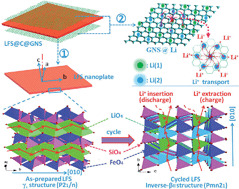Graphene activated 3D-hierarchical flower-like Li2FeSiO4 for high-performance lithium-ion batteries†
Abstract
Development of a cathode material with safety, low cost, high energy and power densities, long life and excellent abuse tolerance for Li-ion batteries is critical for hybrid electric vehicles (HEVs) and electric vehicles (EVs). Here, we developed graphene activated 3D-hierarchical flower-like Li2FeSiO4 with secondary nanopetals (G@3D-HFLFS), which exhibited a discharge capacity of 327.2 mA h g−1 (specific energy of 879 W h kg−1) approaching the full theoretical capacity with large-current and long-life performance. The electrochemical reaction mechanism of G@3D-HFLFS was investigated by Mössbauer spectroscopy and parallel model X-band ESR. The high performance can be attributed to the secondary petal-like structures having an ultra-rapid Li-ion diffusion along the minimum length, the graphene coating layers facilitating double transport of electrons and Li-ions, and the special hierarchical structure with an optimal petal thickness possessing excellent structural stability. These results clearly demonstrate that our novel material is a promising cathode for commercial applications that require high energy and power densities, long operating life and excellent abuse tolerance.


 Please wait while we load your content...
Please wait while we load your content...